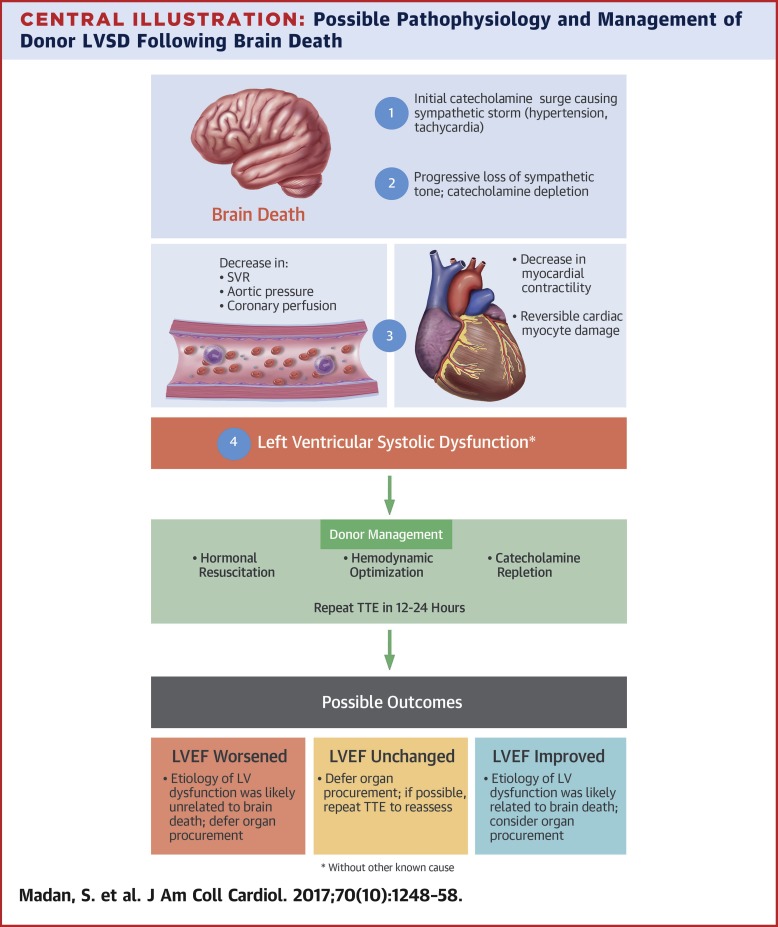当前位置:
X-MOL 学术
›
J. Am. Coll. Cardiol.
›
论文详情
Our official English website, www.x-mol.net, welcomes your
feedback! (Note: you will need to create a separate account there.)
Outcomes After Transplantation of Donor Hearts With Improving Left Ventricular Systolic Dysfunction
Journal of the American College of Cardiology ( IF 21.7 ) Pub Date : 2017-09-01 , DOI: 10.1016/j.jacc.2017.07.728 Shivank Madan , Omar Saeed , Peter Vlismas , Ioanna Katsa , Snehal R. Patel , Julia J. Shin , William A. Jakobleff , Daniel J. Goldstein , Daniel B. Sims , Ulrich P. Jorde
Journal of the American College of Cardiology ( IF 21.7 ) Pub Date : 2017-09-01 , DOI: 10.1016/j.jacc.2017.07.728 Shivank Madan , Omar Saeed , Peter Vlismas , Ioanna Katsa , Snehal R. Patel , Julia J. Shin , William A. Jakobleff , Daniel J. Goldstein , Daniel B. Sims , Ulrich P. Jorde

|
BACKGROUND
Left ventricular systolic dysfunction (LVSD) accounts for almost 25% of nonacceptance of potential donor hearts. Previous smaller, single-center studies showed that LVSD following brain death may be transient, and such hearts can be successfully resuscitated with resolution of LVSD, then transplanted. OBJECTIVES
This study evaluated outcomes of donor hearts with LVSD on initial transthoracic echocardiogram (TTE) that resolved during donor management. METHODS
We reviewed echocardiograms of all cardiac donors in the United Network of Organ Sharing database that were transplanted from January 1, 2007, to September 30, 2015, and identified 472 donor hearts with LVSD (left ventricular ejection fraction [LVEF] ≤40%) on initial TTE that resolved (LVEF ≥50%) during donor management on a subsequent TTE. These patients comprised the improved donor LVEF group. These were compared with donor hearts with normal LVEF (LVEF ≥55%) on the initial TTE for recipient mortality, cardiac allograft vasculopathy (CAV), and primary graft failure (PGF). RESULTS
There was no significant difference in recipient mortality at 30 days, 1 year, 3 years, and 5 years of follow-up, nor any difference in rates of PGF at 90 days and CAV at 5 years between recipients of donor hearts with improved LVEF and recipients of donor hearts with initially normal LVEF. Post-transplant length of stay was also similar between the 2 groups. Using propensity scores, 461 transplants in the improved-donor LVEF group were matched to 461 transplants in the normal-donor LVEF group. There was no significant difference in PGF at 90 days or recipient mortality after up to 5 years of follow-up. CONCLUSIONS
In the largest analysis of donor hearts with transient LVSD, we found that such hearts can be successfully resuscitated and transplanted without increasing recipient mortality, CAV, or PGF. These results underscore the importance of appropriate donor management and should help to increase utilization of donor hearts with transient LVSD.
中文翻译:

供体心脏移植后改善左心室收缩功能障碍的结果
背景 左心室收缩功能障碍 (LVSD) 占潜在供体心脏不接受的近 25%。之前较小的单中心研究表明,脑死亡后的 LVSD 可能是短暂的,这样的心脏可以在解决 LVSD 后成功复苏,然后进行移植。目的 本研究评估了在供体管理期间解决的初始经胸超声心动图 (TTE) 上 LVSD 供体心脏的结果。方法 我们回顾了器官共享联合网络数据库中所有心脏捐献者的超声心动图,这些捐献者在 2007 年 1 月 1 日至 2015 年 9 月 30 日期间移植,并确定了 472 颗患有 LVSD(左心室射血分数 [LVEF] ≤ 40%)的捐献心脏在随后的 TTE 的供体管理期间解决(LVEF ≥50%)的初始 TTE。这些患者包括改良的供者 LVEF 组。将这些与在初始 TTE 上具有正常 LVEF(LVEF ≥55%)的供体心脏的受者死亡率、心脏同种异体移植血管病变 (CAV) 和原发性移植失败 (PGF) 进行比较。结果 LVEF 改善的供体心脏受者之间在 30 天、1 年、3 年和 5 年随访时的受者死亡率没有显着差异,90 天的 PGF 率和 5 年的 CAV 率也没有任何差异和最初 LVEF 正常的供体心脏的接受者。两组移植后的住院时间也相似。使用倾向评分,改良供者 LVEF 组的 461 例移植与正常供者 LVEF 组的 461 例移植相匹配。在长达 5 年的随访后,90 天的 PGF 或受者死亡率没有显着差异。结论 在对暂时性 LVSD 供体心脏的最大分析中,我们发现这些心脏可以成功复苏和移植,而不会增加受者死亡率、CAV 或 PGF。这些结果强调了适当的供体管理的重要性,应该有助于提高对短暂 LVSD 供体心脏的利用率。
更新日期:2017-09-01
中文翻译:

供体心脏移植后改善左心室收缩功能障碍的结果
背景 左心室收缩功能障碍 (LVSD) 占潜在供体心脏不接受的近 25%。之前较小的单中心研究表明,脑死亡后的 LVSD 可能是短暂的,这样的心脏可以在解决 LVSD 后成功复苏,然后进行移植。目的 本研究评估了在供体管理期间解决的初始经胸超声心动图 (TTE) 上 LVSD 供体心脏的结果。方法 我们回顾了器官共享联合网络数据库中所有心脏捐献者的超声心动图,这些捐献者在 2007 年 1 月 1 日至 2015 年 9 月 30 日期间移植,并确定了 472 颗患有 LVSD(左心室射血分数 [LVEF] ≤ 40%)的捐献心脏在随后的 TTE 的供体管理期间解决(LVEF ≥50%)的初始 TTE。这些患者包括改良的供者 LVEF 组。将这些与在初始 TTE 上具有正常 LVEF(LVEF ≥55%)的供体心脏的受者死亡率、心脏同种异体移植血管病变 (CAV) 和原发性移植失败 (PGF) 进行比较。结果 LVEF 改善的供体心脏受者之间在 30 天、1 年、3 年和 5 年随访时的受者死亡率没有显着差异,90 天的 PGF 率和 5 年的 CAV 率也没有任何差异和最初 LVEF 正常的供体心脏的接受者。两组移植后的住院时间也相似。使用倾向评分,改良供者 LVEF 组的 461 例移植与正常供者 LVEF 组的 461 例移植相匹配。在长达 5 年的随访后,90 天的 PGF 或受者死亡率没有显着差异。结论 在对暂时性 LVSD 供体心脏的最大分析中,我们发现这些心脏可以成功复苏和移植,而不会增加受者死亡率、CAV 或 PGF。这些结果强调了适当的供体管理的重要性,应该有助于提高对短暂 LVSD 供体心脏的利用率。











































 京公网安备 11010802027423号
京公网安备 11010802027423号